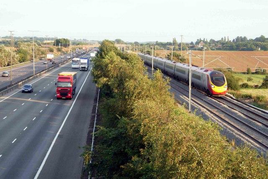Paying for Inland Infrastructure
With emphasis on the Port of Rotterdam
By Lauratu Stijnen, May 2013
Abstract
 This Master thesis represents the last stage of the study Economics & Business with specialization in Urban, Port & Transport Economics in Erasmus University Rotterdam.
This Master thesis represents the last stage of the study Economics & Business with specialization in Urban, Port & Transport Economics in Erasmus University Rotterdam.
The paper tries to answer the question who must and who will pay in the future for the inland transport infrastructure connecting the Port of Rotterdam to the mainland. On a larger scale this thesis represents an explorative, qualitative and critical study on the topic of inland transport infrastructure of seaports. The focus is reduced to road and railway infrastructure in particular and the point of view is kept close to the interests of the Port of Rotterdam.
A solid conceptual framework and an interview-based research are the pillars for the analysis of the data. Examples of provision of inland transport infrastructure from various countries are explored, including the Netherlands. It is argued that procurement of inland transport infrastructure cannot be fully and completely examined unless both variables of such procurement are taken into consideration: financing and funding. Benefits and issues related to public and private financing are explored. Attention is given to private financing through institutional investors which is becoming a viable alternative to long-term traditional bank financing. The funding schemes investigated in this paper are general taxation, user charging from specific taxation, user charging from public and private tolls, donor funding from the European Union, land developers and specific businesses contributions, including ports.
The performed analysis shows that the traditional public financing with public funding approach and the rising private financing with public funding approach are the most viable scenarios for the future of inland transport infrastructure in the Netherlands. On the financing side, institutional investors are a “natural” match for infrastructure procurement and maybe even crucial in a time when long-term bank borrowing is stagnating. Projects deriving from public financing with private funding approaches are possible but only when the business case of the project needs to be supported by private tolls revenue. Pure private financing and funding is a very unlikely scenario, just as schemes where full ownership of the infrastructure is assumed by the private sector. The role of the port as investor in inland transport infrastructure is presented.
Download
Click here to download Lauratu Stijnen's Master Thesis

